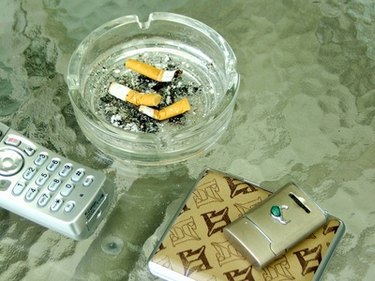Things You'll Need
Drop cloths
Plastic sheeting
Ladder
Detergent
Trisodium phosphate
Bleach
Sponge
Clean buckets
Sponge mop

Smoke residue on your painted walls can build up over time if you use scented candles or have smokers in your home. You may not realize how discolored your walls have become until you take down a picture. A sudden grease fire or tipped-over candle can create black, oily smoke stains on painted surfaces in your home. It's easy enough to throw smoked fabrics into the washing machine, but cleaning smoke stains from paint involves a bit more preparation.
Step 1
Move everything possible out of the area in which you'll be working. Take down window coverings and pictures, move or cover furniture with plastic sheeting, and put old towels or drop cloths along the base of walls or trim.
Video of the Day
Step 2
Mix detergent and warm water in a clean bucket. Use dish washing detergent if the paint isn't heavily soiled. For heavy smoke or soot, the U.S. Fire Administration recommends adding 4 to 6 tbsp. trisodium phosphate (TSP) and one cup of detergent or chlorine bleach to a gallon of water.
Step 3
Start at the bottom of the painted surface and wash the walls with a sponge. The large sponges used for cleaning automobiles work well. Work in sections about 3 feet wide. Use a step ladder to reach the higher wall sections.
Step 4
Rinse each section immediately with a separate bucket of clean water and a clean sponge, again working from bottom to top.
Step 5
Wash ceilings last when cleaning smoke from paint in an entire room. Use a sponge mop designed for floors on ceilings and walls to save your neck and shoulder muscles from strain.
Step 6
Allow the painted surfaces to dry completely before priming and painting.
Tip
Put about 1 cup of vinegar in every gallon of rinse water to help dissipate smoke smell.
Stubborn smoke stains can penetrate paint. If you paint after cleaning the walls, use an oil- or shellac-based primer to prevent stains from coming through the new paint.
Warning
Never mix chlorine bleach with any cleaning product containing ammonia, because you'll create toxic chlorine gas.
Wear gloves and eye protection to protect your skin from cleaning agents, and ventilate the area with open windows and fans while working.
TSP may dull glossy surfaces. Test strong detergents on a section of the paint first if you don't plan on repainting after cleaning.
Video of the Day